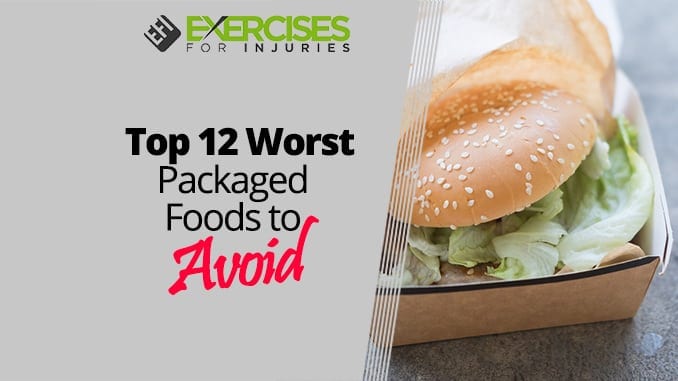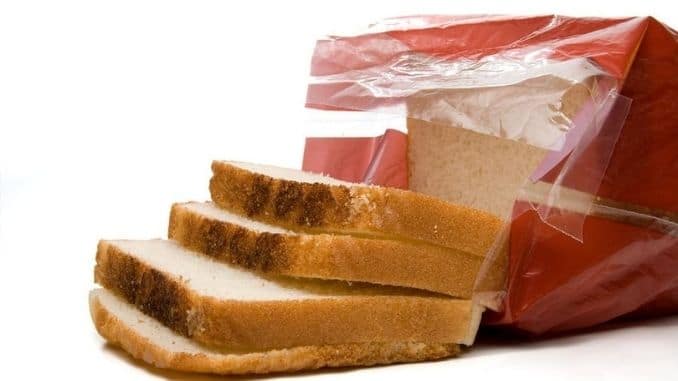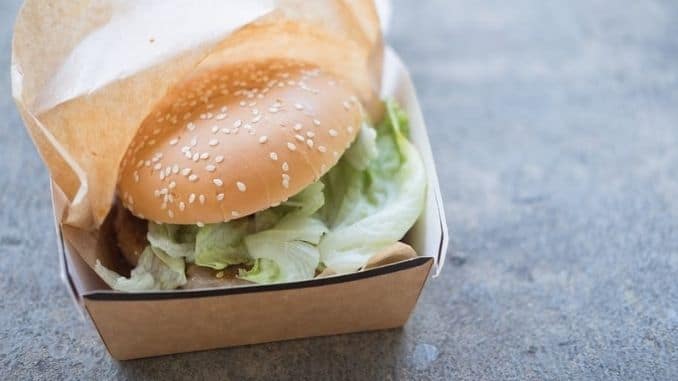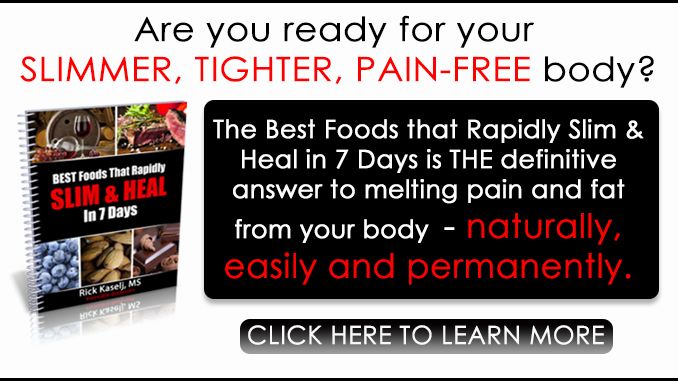
When it comes to eating, fresh food is always best. Anything that comes in a package could certainly have many unhealthy ingredients. Still, some packaged foods are much worse than others. Since the best thing to do is read the label, we’ll focus on harmful ingredients. Surprisingly, what the package itself is made of can be dangerous too. We’ll also share a list of the 12 unhealthiest packaged foods of all. Ready?
Dangerous Packaging
Before we look at what’s inside the food, what about the package itself? Essentially every packaged food comes into contact with some kind of plastic. Even that paper bread bag might also be lined with a plastic coating. So, This contact means that small amounts of plastic get absorbed into our food.
Monitoring by the Centers for Disease Control and Prevention (CDC) shows that more than 90 percent of people have detectable levels of the plastic component bisphenol A (BPA) in their bodies. Moreover, this chemical may affect the function of hormones like estrogen. One large study showed that those who have high levels of BPA in their urine have higher rates of diabetes, heart disease, and also liver toxicity. Other plastic-based chemicals called phthalates are certainly believed to block the action of testosterone. In pregnant women, phthalates may also affect fetal development.
The best strategy is indeed to avoid plastic containers — bottles, cups, plates and packages — that are made from polycarbonate. Look for the number 7 or the letters “PC” on the package. Also, try to store food in glass or porcelain containers.
Dangerous Unhealthiest Packaged Foods
You might not think of fast food as “packaged,” but it comes in a box, right? Approximately 30 percent of fast-food containers contain grease-repelling coatings made of perfluorinated chemicals (PFC or PFAS), according to a recent Environmental Working Group study. As if fast food itself wasn’t dangerous enough, now they put it in a toxic box.
Furthermore, perfluorinated substances have been correlated to cancer, developmental problems, reproductive damage, immune system disorders, and other health problems. These chemicals used to be found in nonstick cookware, but their use has been phased out due to the health risks. Now, these chemicals are indeed appearing again in fast food packaging.
However, not all packaging contains these substances, and are the unhealthiest packaged foods. It can also be sporadic and regional. For instance, the same fast-food brand may have PFC boxes in Idaho but not in Florida.
Substances Found In Foods
1. Trans Fats
-
Where You Find Them
Packaged baked goods, crackers, cookies, microwave popcorn, margarine, and donuts.
-
What Food Labels Call Them
Partially hydrogenated, fractionated, or hydrogenated oils.
The crazy thing is that years ago, trans fats were considered a “healthy” substitute for fatty foods. That’s why so many people switched from butter to margarine at one point. However, as medical science began to investigate the causes of heart disease, trans fats were found to be very dangerous. In fact, trans fats are twice as dangerous to your arteries as saturated fats — those that come from animal sources.
Moreover, Trans fats deliver a double whammy to your heart by elevating LDL “bad” cholesterol and lowering HDL “good” cholesterol. This packaged food ingredient may be responsible for up to 100,000 heart-related deaths per year. Also, some evidence indicates that trans fats may increase your risk for type 2 diabetes.
2. Refined Grains
-
Where Do You Find Them
White bread, buns, box cereals, pasta, white flour, and white rice.
-
What Food Labels Call Them
Surprisingly, some labels like wheat flour, multigrain, or seven-grain might be high in refined grains.
If you eat too much of these starchy foods, you could certainly be increasing your risk for high cholesterol, high blood pressure, heart attacks, insulin resistance, diabetes, and obesity.
Instead, opt for 100 percent whole grains, such as:
- Barley
- Brown rice
- Buckwheat
- Bulgur (cracked wheat)
- Millet
- Oatmeal
- Popcorn (not microwave)
- Whole-wheat bread, pasta or crackers
Increased consumption of whole grains has been shown to reduce heart disease by 20 to 30 percent. Look for a fiber content of at least 3 grams per serving. Be careful, however, as many bread items sold with a whole grain label have refined grains as an ingredient. Read the ingredients.
3. Sugar And High Fructose Corn Syrup
-
Where You Find Them
In many sweetened foods. Hidden in bread, buns, muffins, ketchup, soft drinks and also in spaghetti sauce.
-
What Food Labels Call Them
Other names for sugar may contain the words nectar, malt, sucrose, dextrin, dextrose, maltose, maltodextrin, fruit juice, glucose, sweetener, and also molasses.
Furthermore, added sugar is found in nearly 75 percent of packaged foods. Too much sugar in your diet can certainly increase your risk for obesity, heart disease, fatty liver, leaky gut, diabetes, some cancers. High fructose corn syrup appears to be especially harmful since it appears to affect your appetite to encourage overeating. The average adult consumes 63 pounds of high fructose corn syrup per year. Yikes.
4. Salt
-
Where You Find It
Like sugar, salt is nearly ubiquitous in packaged foods. Chips and salad dressings are just the tip of the iceberg. Also in canned or packaged meat, bread, soy sauce, soup and soup mixes.
-
What The Labels Call It
Any ingredients containing the words salt or sodium mean the food indeed has salt.
The recommended limit is 1500mg of sodium amounts — 0.75 teaspoons or 3.75 grams of salt — per day. The average adult consumes more than double the recommended limit of salt per day. This is one of the reasons why high blood pressure is so common.
Other Additives
Some other common additives to avoid are:
-
Monosodium Glutamate (MSG)
Flavor enhancers found in soups, salad dressings, chips, frozen foods, and restaurant food. These may contribute to depression, disorientation, eye problems, tiredness, headaches, and also obesity.
-
Food Dyes
Any ingredient that has the words red, yellow, blue, or color; may contribute to behavioral problems in kids or IQ reduction.
-
Sodium Sulfite
Found in wine and dried fruit; may indeed lead to asthma attacks in sensitive persons.
-
Sodium Nitrate/Sodium Nitrite
Preservatives in processed meats; may cause cancer and be harmful to the pancreas and liver; make meats look red and fresh.
-
BHA And BHT (E320)
Found as a preservative in cereals, chewing gum, potato chips, and vegetable oils; might be cancerous and could affect brain function.
-
Sulfur Dioxide (E220)
Considered toxic and can worsen asthma; found in beer, soft drinks, dried fruit, juices, alcoholic drinks, wine, vinegar and chips, and snack food.
-
Potassium Bromate
Volume enhancers found in flour and bread; may be cancerous.
The Dirty Dozen
Here’s a list of the top 12 worst and unhealthiest packaged foods to avoid:
1. Deli Meats
Ultra high in sodium and may contain sodium nitrate which has been linked to cancer; typically high in fat.
2. Diced Chicken Breast
Can contain up to 14 ingredients that aren’t chicken makes it the unhealthiest packaged foods.
3. Hot Dogs
Notoriously high in fat, sodium, and preservatives. Many brands even include corn syrup in the mix; meat trimmings are from beef, chicken, and also pork sources that are never grass-fed or free-range.
4. Sausages
Very similar to hot dogs; full of fat, sodium, and preservatives.
5. Veggie Or Soy Burgers
Not indeed a healthy food; full of sodium and often low in protein; may contain preservatives as well.
6. Chicken Nuggets
High in fat and sodium; breading comes from refined grain sources.
7. Sliced Cheese Singles
Lots of sodium; individually wrapped slices in contact with plastic more than any other food.
8. Biscuits
Packed with trans fats, refined grains, sugar, and salt.
9. Boxed Cereals
Usually high in refined grains and sugar; often contains artificial coloring.
10. Sliced White Or Wheat Bread And Bagels
Fully loaded with refined grains, sugar, and salt; remember, whole-grain labeled bread can have refined grains mixed in.
11. Tortilla Wraps
Often have a long list of ingredients including refined grains, vegetable shortening, and salt.
12. The Obvious Offenders
Candy, pastries, snack foods, chips, quick dinners, cake mixes, and many more.
Eat Fresh First
In conclusion, Quinoa noodles, whole grain bread, organic chips, buckwheat biscuits, gluten-free cookies — sounds healthy, right? Well, sneaky marketing tactics often indeed use health buzzwords to sell foods with low nutritional value. Therefore, the take-home message is don’t just read the title. So, read the label. Even better: make sure most of your food doesn’t come with a label at all.
For your guide to the best foods to heal your body, check out The Best Foods that Rapidly Slim & Heal in 7 Days, here!




